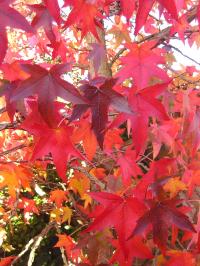Autumn Colour
 A Liquidamaber styraciflua displaying breathtaking autumn colour
A Liquidamaber styraciflua displaying breathtaking autumn colourWhat causes foliage to change colour at this time of year?
The term "autumn colour" has always been and probably will always be a reference to the dramatic changing colours displayed by deciduous trees and shrubs at this time of year.
For the purpose of this article I will focus on this annual event and what causes it to occur. But it is a shame that we often forget about those plants that also provide colour and interest in the garden during the autumn months with their colourful flowers, fruits and bark. Before I talk about the main event or "the fall" as it is referred to in the U.S.A. spare a thought for amongst others, Colchicum speciosum, Nerine bowdenii, Sorbus cashmiriana and Liriope muscari who all have to play second fiddle to the spectacle that we truly consider to be "autumn colour".
It's funny how during the autumn months we marvel at and enjoy what is actually death on a massive scale. Autumn marks the end of the road for trillions of leaves. The deciduous plants whose leaves are about to fall are not on the way out of course but for the leaves, senescence is finished and a slow death is almost complete as they reach the end of their lives.
Autumn colour is all about pigments. Pigments are best described as substances that are capable of absorbing light. They are also able to reflect different wavelengths of light which determines the colour of the pigment.
The most common pigment found in leaves, found in the greatest quantities is chlorophyll. Because chlorophyll reflects green light it gives leaves a predominantly green appearance. Chlorophyll absorbs some of the light and uses it in the process of photosynthesis.
In most leaves, the quantities of other pigments are so small that they are masked by the dominant chlorophyll for most of the year. In some leaves, chlorophyll is not the dominant pigment e.g. a purple pigment is dominant in the leaves of the copper beech.
As autumn approaches, chlorophyll production slows down and eventually stops. As this happens, the less dominant pigments that are masked but present in the leaves all year round begin to show their colours as the chlorophyll diminishes. These include the yellow carotenoids and the red anthocyanins.
It is thought that the development or onset of autumn leaf colour change is instigated by temperature changes and a reduction in day length. The intensity and quality of autumn leaf colour displayed by deciduous trees and shrubs in the U.S.A. is thought to be of a higher standard than herein the U.K. because the night-time temperature drops there are greater.
My favourite plants for an excellent display of autumn leaf colour are:
- Acer palmatun 'Atropurpureum'
- Ceratostigma willmottianum 'Forest Blue'
- Cotinus coggygria 'Royal Purple'
- Euonymus alatus
- Parthenocissus quinquefolia
- Rhus typhina
- Acer rubrum
- Amelanchier lamarkii
- Cercidiphyllum japonicum
- Liquidamber styraciflua 'Worplesdon'
- Parrotia persica
- Sorbus commixta 'Embley'
- Vitis coignetiae
- Nyssa sylvatica
- Fraxinus angustifolia 'Raywood'
Filed under Autumn Colour.
